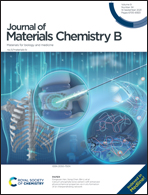Polyethylenimine-modified graphitic carbon nitride nanosheets: a label-free Raman traceable siRNA delivery system†
Abstract
Since the nanotoxicity of gene delivery carriers has raised world-wide concerns, it is important to trace their intracellular performance, for example via uptake visualization. Here, we develop a novel ultrathin graphitic carbon nitride (g-C3N4) composite nanosystem for label-free Raman-traceable small interfering RNA (siRNA) delivery. Through low molecular weight polyethylenimine (PEI) modifications, these nanosystems can obtain siRNA loading capabilities. The lateral size of the PEI-g-C3N4 composite is around 100–150 nm with a thickness of nearly 0.6 nm. The designed label-free delivery system could avoid possible obstacles associated with artificial labels and it shows cytotoxicity toward cancer cells and good biocompatibility in normal human cells. The label-free PEI-g-C3N4 gene nanocarrier can be directly traced via Raman microscopy, which makes it suitable for intracellular visualization. Intracellular uptake of the self-fluorescent g-C3N4 nanosheets can also be traced via fluorescence imaging. The PEI modified g-C3N4 ultrathin nanosheets possess gene delivery capacity together with unique dual-traceable Raman and fluorescence features. Raman traces not only have higher specificity than fluorescence ones but they can also avoid background noises. Thus, they may replace widely implemented fluorescence tracing. This work could provide a label-free traceable platform for investigating the intracellular performances of gene delivery nanosystems.



 Please wait while we load your content...
Please wait while we load your content...